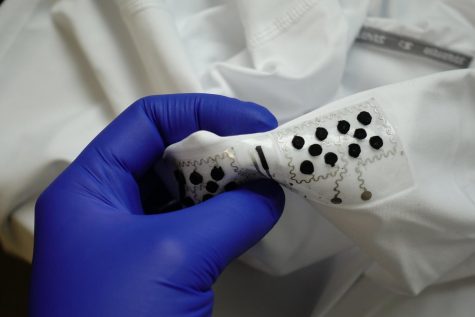Wearable Generator Uses The Human Body To Power Small Devices
The wearable microgrid uses energy from human sweat and movement to power an LCD wristwatch and electrochromic device. Credit: Lu Yin
At the University of California San Diego, nano engineers have created a “wearable microgrid” that harvests and stores energy from different parts of the body to fuel small devices.
Sweat-powered biofuel cells, motion-powered devices called triboelectric generators, and energy-storing supercapacitors are the three main components of this device. Due to the fact that this is a wearable device, all of these parts are flexible, washable, and can be screen-printed onto clothing or any other fabric.
On the shirt itself, the parts are all connected by flexible silver interconnections that are printed on the shirt and given a waterproof coating. The parts are not damaged by the forces of repeated bending, folding, crumpling, or washing in water, just make sure you don’t use detergent.
A nanoengineering Ph.D. student at UC San Diego Jacobs School of Engineering and co-first author of the paper named Lu Yin said “We’re applying the concept of the microgrid to create wearable systems that are powered sustainably, reliably and independently. Just like a city microgrid integrates a variety of local, renewable power sources like wind and solar, a wearable microgrid integrates devices that locally harvest energy from different parts of the body, like sweat and movement, while containing energy storage.” A collection of flexible electronic parts were put into the building of this microgrid. Each part was screen printed onto a shirt and placed in the optimal location for energy collection. The flexible parts were designed by the UC San Diego Nanobioelectronics team’s professor Joseph Wang. Wang is also the director of the Center for Wearable Sensors at UC San Diego and a corresponding author on the present study.

Inside the shirt, at the chest level, is where you would find the biofuel cells that harvest energy from sweat. On the outside of the shirt, still at chest level, is the location of the supercapacitors that temporarily store energy from the other two devices and then pass it onto the small electronics to power them. Outside the shirt, on the forearms and sides of the torso near the waist, is where the triboelectric generators live. The triboelectric generators convert energy from the swinging movement of the arms against the torso while running or walking into electricity. With two ways to harvest energy, the wearable microgrid can continuously power devices at a fast pace. The movement and sweat play into each other as well, seeing as energy can be harvested immediately when the user starts moving, but then after enough movement, the user begins to sweat, thus allowing the biofuel cells to collect even more energy. Yin states “When you add these two together, they make up for each other’s shortcomings. They are complementary and synergistic to enable fast startup and continuous power.” The triboelectric generators help the biofuel cells harvest energy at twice the speed, while the biofuel cells help the triboelectric generators last up to three times longer. Each wearable also provides power in a different way. The biofuel cells send out continuous low voltage, as opposed to the triboelectric generators, which give sudden pulses of high voltage. The supercapacitors act as a storage room for the energy that both power sources give off until they are discharged at need. Some of the research for this project dates all the way back to 2013 when Wang’s team first reported the sweat-harvesting properties of the biofuel cells. Over time, the technology was updated and upgraded to be strong and flexible enough to power small electronics.
The testing of this device was on a subject during 30-minute sessions. The first 10 minutes were spent either on a cycling machine or running, with a full 20 minutes of rest afterward. Each session generated enough power to fuel an LCD wristwatch or a small electrochromic display-a device that changes color in response to an applied voltage. This device is quite convenient for athletics or any exercise in general, seeing as it uses movement and sweat as an energy harvesting place. However, this is only one way it can be used, and the researchers are working on other designs that can collect energy from something as simple as sitting down or slowly moving. Technology has gone very far in the past decade and this device is proof of it. It takes some serious technological know-how to develop a device that can use the human body as an energy source, and UC San Diego’s nano engineers have done just that.
RELATED STORIES:
https://www.nature.com/articles/s41467-021-21701-7
https://techxplore.com/news/2021-04-small-captures-skin-power-wearable.html
https://www.cell.com/cell-reports-physical-science/fulltext/S2666-3864(21)00102-8
https://jacobsschool.ucsd.edu/news/release/3233
https://techxplore.com/news/2021-03-wearable-microgrid-human-body-sustainably.html















